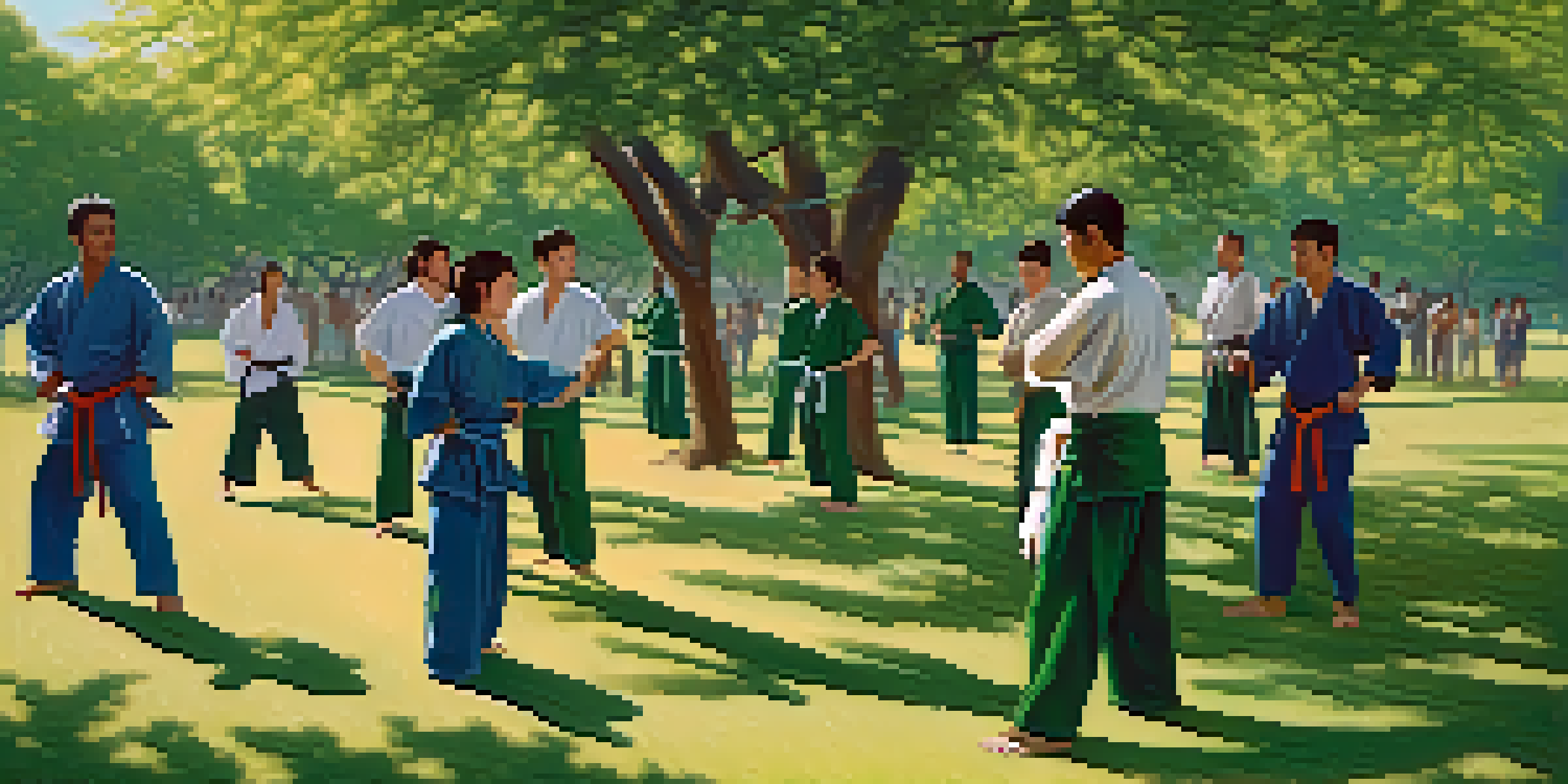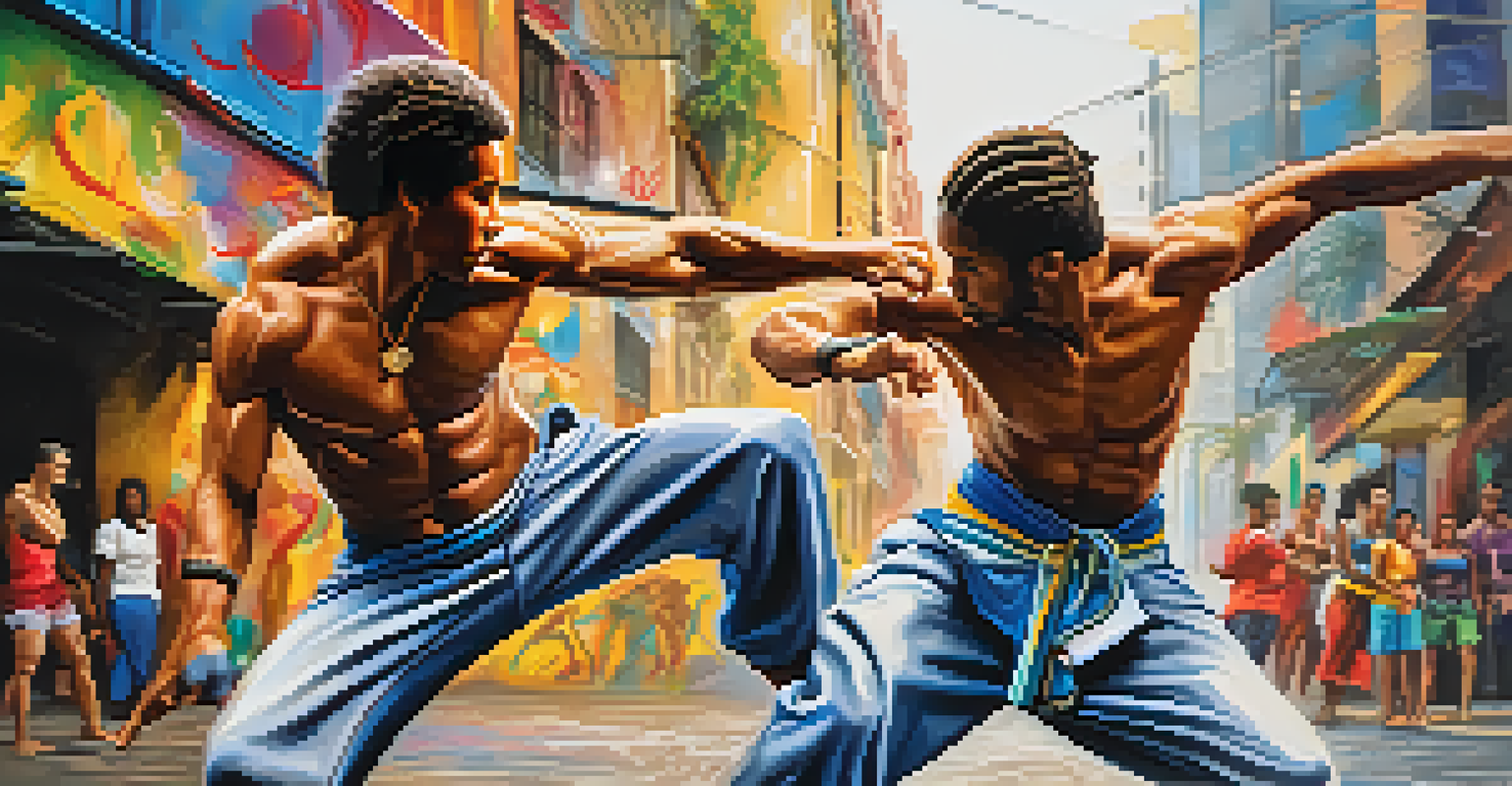The Evolution of Self-Defense Techniques Across Cultures

Understanding Self-Defense: A Universal Need
Self-defense is a fundamental instinct that transcends cultural boundaries. Across the globe, people have developed techniques to protect themselves from harm, driven by the need for safety. This instinct is not just biological; it’s deeply rooted in social contexts and historical experiences. From ancient tribes to modern societies, the methods may differ, but the underlying motivation remains the same: survival.
The greatest weapon against stress is our ability to choose one thought over another.
Historically, self-defense was often a communal effort, with entire tribes coming together to fend off threats. In many cultures, fighting skills were passed down through generations, emphasizing the importance of community solidarity. The evolution of these techniques reflects the changing dynamics of society, including advancements in technology and shifts in social structures. As threats evolved, so too did the strategies individuals employed to protect themselves.
Today, self-defense is recognized not only as a physical skill but also as a psychological one. Learning to assert oneself and de-escalate potential threats has become just as crucial as mastering physical techniques. This holistic approach to self-defense highlights its evolution from mere survival tactics to a comprehensive form of personal empowerment.
Ancient Self-Defense Techniques: The Roots
In ancient times, self-defense techniques were often rudimentary, focusing on the use of natural weapons like sticks or stones. For instance, in ancient Greece, the art of Pankration combined elements of boxing and wrestling, allowing individuals to use their entire body to fend off attackers. This practice not only trained warriors but also played a role in social rituals and competitions, showcasing strength and skill.

Similarly, in East Asia, martial arts like Kung Fu developed from the need for self-protection and military training. These techniques were not just about physical prowess; they often incorporated philosophical elements, emphasizing discipline and respect. The stories of legendary martial artists highlight how these ancient practices became a way to convey cultural values while teaching self-defense.
Self-Defense: A Universal Instinct
Self-defense is a fundamental instinct shared across cultures, evolving from communal practices to individual empowerment.
As civilizations grew, so did the complexity of their self-defense techniques. The blending of different cultures through trade and conquest led to the exchange of fighting styles, enriching the methods available to individuals. This cultural fusion laid the groundwork for the diverse self-defense practices we see today.
Medieval Self-Defense: The Age of Armor and Swordplay
During the medieval period, self-defense took on a new dimension with the advent of armor and weaponry. Knights and warriors trained rigorously in the arts of swordplay and hand-to-hand combat, often in formalized settings. The techniques developed during this era were not just about personal safety; they were also crucial for maintaining honor and status within feudal societies.
Self-defense is not just about physical strength; it is about the empowerment of the mind and spirit.
In Japan, this period saw the rise of the samurai, who practiced various forms of martial arts, including Kenjutsu (sword techniques) and Jujutsu (unarmed combat). These techniques were often accompanied by a strict code of ethics, known as Bushido, which emphasized honor and respect. This blend of martial skill and moral philosophy created a unique approach to self-defense that is still revered today.
Interestingly, many medieval self-defense techniques were documented in manuals and treatises, allowing knowledge to be preserved and passed on. The legacy of these writings continues to influence modern martial arts, showcasing how historical practices have shaped contemporary self-defense methods.
Colonial Influences: The Global Exchange of Techniques
The colonial era marked a significant shift in self-defense techniques as cultures collided and exchanged knowledge. European colonizers encountered indigenous fighting styles, leading to a blend of techniques that adapted to new environments and challenges. This cross-cultural interaction often resulted in hybrid martial arts that incorporated elements from both sides.
For instance, in the Caribbean, enslaved Africans developed forms of self-defense that blended traditional African martial arts with European styles. Practices like Capoeira emerged as both a means of self-defense and a way to preserve cultural identity under oppression. These unique adaptations highlight the resilience of communities and their ability to innovate in the face of adversity.
Cultural Diversity in Techniques
Self-defense methods vary globally, reflecting unique cultural values and adapting through historical exchanges and innovations.
Moreover, as global travel increased, so did the awareness of various self-defense techniques. People began to adopt styles from different cultures, leading to a richer tapestry of martial arts. This evolution illustrates how self-defense methods are not static; they are dynamic and continually shaped by historical events and cultural interactions.
Modern Self-Defense: From Martial Arts to Self-Protection
In contemporary society, self-defense has evolved to encompass a wide range of practices, from traditional martial arts to modern self-protection classes. The rise of personal safety awareness has led to the development of programs specifically designed for self-defense in real-world scenarios. These classes often focus on practical techniques that can be applied in everyday situations, making them accessible to everyone.
Self-defense training today emphasizes empowerment, teaching individuals, especially women, to recognize and avoid potentially dangerous situations. The curriculum often includes verbal de-escalation tactics, situational awareness, and physical techniques. This shift reflects a broader understanding of self-defense as both a physical and mental practice, promoting confidence and assertiveness.
As technology advances, so does the approach to self-defense. With the rise of self-defense apps and online tutorials, individuals have various resources at their fingertips. This technological integration has made self-defense education more accessible, allowing people to learn at their own pace and comfort level, further democratizing the practice.
Cultural Variations: Unique Approaches Around the World
Self-defense techniques vary widely across cultures, each offering unique perspectives on protection and safety. In Brazil, for example, Capoeira combines dance with martial arts, creating a dynamic form of self-defense that is both artistic and functional. This cultural approach emphasizes movement and rhythm, demonstrating how self-defense can be more than just a physical confrontation.
In contrast, Krav Maga, developed in Israel, focuses on practical and efficient techniques for real-life situations. It incorporates elements from various martial arts and emphasizes quick, decisive actions to neutralize threats. This straightforward approach highlights the importance of adaptability and effectiveness in self-defense training.
Future Trends in Self-Defense
The future of self-defense is increasingly influenced by technology and mental resilience, focusing on practical training for real-world scenarios.
Understanding these cultural variations enriches our appreciation for self-defense as a global phenomenon. Each style reflects the values, history, and environment of its culture, demonstrating how diverse the concept of self-protection can be. By exploring these differences, we gain insight into the shared human experience of seeking safety and empowerment.
The Future of Self-Defense: Trends and Innovations
As society continues to evolve, so too does the landscape of self-defense. One notable trend is the growing emphasis on mental resilience and emotional intelligence as critical components of self-defense training. Programs are increasingly integrating psychology, teaching individuals how to manage fear, anxiety, and stress in threatening situations.
Additionally, technology is playing a significant role in shaping the future of self-defense. Virtual reality (VR) training and apps that simulate real-life scenarios are becoming popular tools for learners. These innovations provide immersive experiences that enhance skills without the physical risks associated with traditional training methods.

Looking ahead, it’s clear that self-defense will continue to adapt to the needs of society. Whether through the integration of technology or a deeper understanding of psychological aspects, the evolution of self-defense techniques will likely reflect broader societal changes, ensuring that personal safety remains a priority for all.